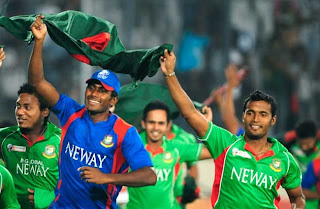
Sri Lanka would do well to forget this tournament altogether. Upul Tharanga has demonstrated in the last handful matches that he is at home at No. 6. Chamara Kapugedera showed great fight and maturity when the top order collapsed to Nazmul Hossain. In every sense, the recent CB Series in Australia was a much better showing in a harder tournament, given the conditions. Sri Lanka would do well to not lose too much sleep over their three losses, and shift focus to their first Test against England which begins in less than a week.
Bangladesh will go into the final with a focused confidence. Since losing the curtain-raiser to Pakistan, they were forced to play with their backs to the wall, and won gritty contests. The only change Bangladesh made to the playing XI was to bring in Nazmul Hossain for Shafiul Islam after their win against India for the Sri Lanka match. Nazmul rewarded the coaching staff with three early breakthroughs and was the second-best player on either team after the ever-consistent Shakib Al Hasan. If there was a criticism to be made of Mushfiqur Rahim’s captaincy in the field, it was his late bowling changes that kept a wayward Shahadat Hossain running in while Nazmul languished on 3 for 22 with two overs to spare.
The team management has shown their willingness to tinker with a winning line-up, and they will surely consider sitting Shahadat, whose expensive figures belie his scattershot line. With an economy rate of 7.12, Shahadat has consistently been the most expensive bowler in an attack that prides itself on manufacturing dot balls and restricting single to apply pressure. Shahadat’s best match came against Pakistan where he took 3 for 53 from 8, and if he is kept for the final it will be on the hope that he can repeat that effort.
Looking for a change, Shafiul Islam could be brought back to strengthen the attack. Conversely, Bangladesh might look to strengthen the batting depth which was bowled out by Pakistan when they last met 21 runs short with two overs to go. In that case, they would do well to field a left-hander near the top with Imrul Kayes or Elias Sunny.
Where Bangladesh go into the final riding two victories, Pakistan does so on their only loss. Even though Pakistan won when the two sides met in their league match, the final will offer them a chance at redemption as they hope to improve on what was their worst performance of the tournament.
Pakistan will certainly make changes. Wahab Riaz will be the first to go after conceding a half-century with the ball in four overs. Sarfraz Ahmed must return to take the gloves after Umar Akmal played stand-in. That experiment cost Pakistan at least 20 runs in the field compounded by the loss of Umar Akmal marshalling the offside field from point and gully.
Those are the quick and easy fixes. George Bernard Shaw famously said, ‘Youth is wasted on the young.’ If there is any truth to the other side of the saying, then Misbah-ul Haq is proof that, ‘Experience is a burden to the old’. Misbah must make full use of his resources and trust Hammad Azam with the ball. His decision to not continue with Mohammad Hafeez’s offspin after taking Gambhir’s wicket in the first over against India showed too much reliance on the pre-match strategy. Hafeez had established himself as a threat with this second delivery and Misbah kept him out of the attack until the 12th over, by which point Tendulkar and Kohli had added 63 easy runs. Fortunately for Pakistan, Younis Khan found some form against India, and it was only an audacious blinder from the cat-like Raina that kept the batting side from posting a score north of 350.
One man who should find himself in a position similar to that of Shahadat Hossain is Shahid Afridi. It should have happened by now, but soon everyone will realize that Afridi is not doing enough to earn his place in the side. He positions himself as an allrounder, but his best days with either tool are behind him. Afridi is a liability with the bat and his bowling has been wayward. Like Shahadat, Afridi has the worst economy in his squad among those who sent down more than 4 overs. Like Shahadat, his reputation and the fact that his best (read: least worst) performance came against the other finalist will probably be enough to keep him on the field.
If Afridi is being played as a specialist bowler, the conditions point to Abdur Rehman, though that change is unlikely given the left-arm man has not played in the tournament. Bangladesh took more Pakistani wickets than any other opponent, so if Afridi makes room for a batsman, Asad Shafiq and Azhar Ali are waiting in the wings, each of whom can sneak in a few overs of part-time legspin.
Bangladesh will prefer to chase their target, while Pakistan will prefer to defend theirs. This strategy will make the coin toss a formality and begin the chess match from the opening delivery. The final looks a contest to be won with the ball, and both teams will fancy their chances. As often happens when bowling is the focus of a match, it is the fielders who ultimately decide the contest, and Bangladesh hold a strong advantage in that department.
The Pakistan team has always had a second home in Bangladesh. The fans treat them as well as their own. This will be a moment of great pride for Bangladesh, possibly 100 overs away from being crowned the champions of Asia, and Pakistan will have to weather as hostile crowds as the friendly smiles in Dhaka can muster.








